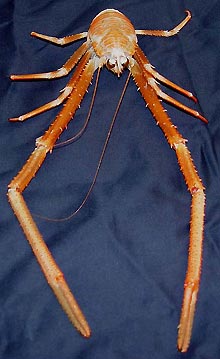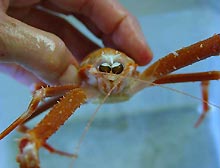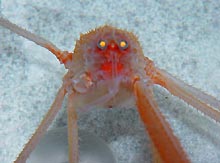
Fig 1: Galatheid crab (possibly a Eumunida species), showing the extremely long claws they possess that enable them to cling to the inside of the suction sampler so tenaciously. Click image for larger view.
Plan C
August 21, 2005
Tamara Frank, Ph.D.
Biological Oceanographer
Harbor Branch Oceanographic Institution
![]() Video
of the galatheid crabs collected with the suction tube
Video
of the galatheid crabs collected with the suction tube
Latitude: 26° 19.916' N
Longitude: 84° 45.855' W
A great sage (Jim Sullivan, HBOI sub pilot) once said “It isn’t how you handle plan A that matters; it’s how you deal with plan B”. Well, for many scientists, you have to have plans C, D, and E in the works as well.
I went for my first sub dive on Operation DeepScope 2005 this afternoon, excited about collecting my new shrimp traps, which had been deployed on the morning dive. Unfortunately, instead of being deployed in the open plain area, where many shrimp were seen walking/swimming on the morning dive, they were deployed next to rocky ridges, which seemed to be the preferred habitat of large cancer crabs. Cancer crabs are lovely animals, but they tend to have tiny eyes, signifying reduced sensitivity and not, therefore, what we currently want as study subjects. They also have large bodies, far too big to get into my traps, and certainly too large to fit into the water bath I use with my electrophysiological set-up. While there are some smaller crustaceans (galatheid crabs, also known as “squat lobsters,” and shrimp) around these rocky ledges, the cancer crabs were so impressed by my traps that they guarded them tenaciously, sitting on top, below and virtually all around them. When submersible pilot Tim Askew Jr. attempted to recover the traps with the claw on the end of the manipulator arm, he had to shake the trap several times to get the cancer crabs to let go. Unfortunately, this barrier of cancer crabs prevented smaller crustaceans, which could have fit through the openings of the traps, from even getting close. So, the new traps were empty, and we went to Plan B.

Fig 2: Photo shows close-up of photoreceptors of crab collected from 1800 feet. The enormous size of these eyes suggests that they are adapted for extremely high sensitivity to light. Click image for larger view.
Plan B was to use the submersible’s suction arm to “slurp up” some smaller crabs and shrimp. In order to prevent the animal from being slurped all the way through the arm and into one of the buckets on the front of the sub (which were not light tight or temperature insulated), a stainless steel screen was placed near the end of the suction opening. This would provide a barrier against which to maintain the crab with suction until the arm was moved to one of the Bio-Boxes. Reverse suction would then (theoretically) drop the animal into the Bio-Box. Well, theory is a wonderful thing, but biology often doesn’t cooperate. The steel screen has three small arms on it, which loop around the end of the suction tube to prevent the screen from being suctioned through the suction sampler. The galatheid crabs have extremely long claws (Fig. 1), and clung to these arms with all their might. It proved virtually impossible to get them out of the suction tube, as they maintained their hold throughout our shaking and reverse suction maneuvers. After slurping up one stubborn little crab, we gave up on attempting to eject it into the Bio-Box, and went after another one. Eventually, three crabs were clinging tenaciously to the inside of the suction tube. To add to the fun, all these collections had to be carried out under dim orange and red light, so as not to blind the animals we were trying to capture for vision studies. These animals have enormous photoreceptors (eyes) (Fig. 2), which is why I’m out here trying so determinedly to collect them. They have never been collected before without being blinded, either by submersible lights or surface lights (I’m beginning to see why). Based on my studies of deep living animals from the water column, I know that most deep sea species have very low sensitivity to red light. Therefore, we’re collecting them under red light, in hopes of not damaging their photoreceptors. Unfortunately, our human sensitivity to red light is fairly low as well, so most of the dive consisted of crouching forward and straining to pick out eyeglow (Fig. 3) in the dim red background. The camera has considerably higher red sensitivity, but a considerably smaller field of view, and hot spots that looked tantalizing like eyeglow turned out to be bright patches on rocks.

Fig 3:Another species of galatheid (squat lobster) showing distinct eyeglow, which results when light hits the reflecting tapetum behind the retina. Click image for larger view.


























